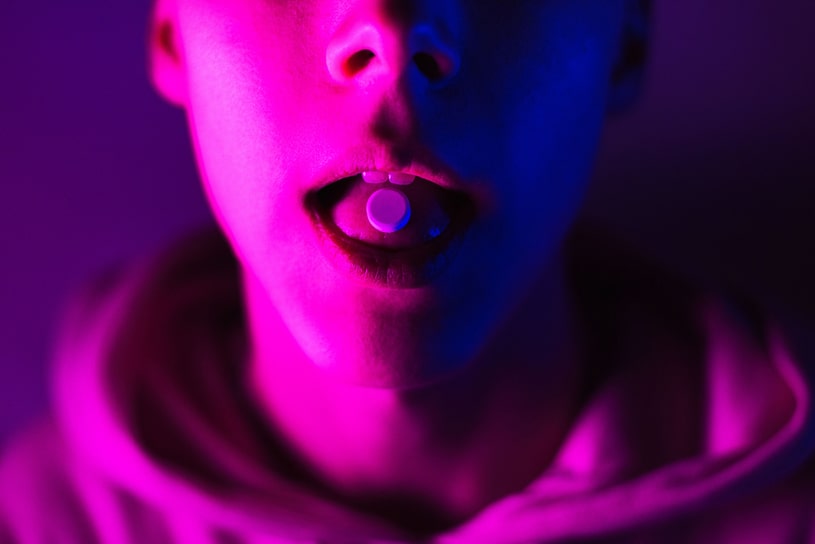In most cases, lysergic acid diethylamide overdose results in the body rapidly absorbing the acid into the bloodstream. Then, the blood flow will help it reach the brain. It is available in the form of oral pills, capsules, and occasionally liquids.
LSD (D-lysergic acid diethylamide acid) is a powerful hallucinogen. It means it can result in hallucinations after the user takes it. Furthermore, the chemical may have effects long after the initial “trip.”
Table Of Contents:
The threshold dose of LSD overdose spectrum is around 300 micrograms. As the dosage increases beyond this arbitrary set point, reports suggest an increase in the intensity of the drug’s effects. However, it is essential to note that different individuals will respond differently to similar doses of any drug. Scientists are still investigating the properties of this drug, but some tests are difficult to do because the half-life of LSD is very small, and traces of the drug disappear almost simultaneously as its effect stops.
Symptoms of LSD Overdose
While the impacts of lysergic acid diethylamide are not lethal, it is conceivable to overdose on acid. Symptoms of a bad trip may occur in a few hours of the intake of LSD. Such side effects can incorporate paranoia, panic, and delusions. However, clinical consideration is required to treat an acid overdose in case the below-mentioned symptoms happen:
The early signs may include:
- Extremely enlarged pupils
- High blood pressure
- Racing pulse
- Excessive shakiness
- Drowsiness
- Nausea and vomiting
- Diarrhea
- Abnormal sweating
- Flushing of the skin
- Tingling sensation
- Wakefulness
A set of potentially dangerous symptoms may occur. These include:
- Too fast or too slow heartbeat
- Very high body temperature (hyperthermia)
- Convulsions
- Coma (very rare)
- Extreme restlessness
- No breathing
- Bleeding problems
Risk Factors
The effects associated with LSD overdose are variable and depend upon the amount of drug taken, the surroundings in which it is used, and the user’s personality, mood, and expectations.
People who are at risk of acid overdose may include:
- Young female users of LSD reported a history of physical abuse and were categorized as having severe depressive symptomatology.
- Pregnant users of acid increase their risk of miscarriage and birth complications. In the case of a mother using hallucinogens during breastfeeding, the drug will likely be led through her milk to the baby causing adverse effects.
- Drivers result in distorting their sense perceptions, poor coordination, and lack of judgment by overdosing on acid, which is extremely dangerous to drive.
- Polydrug users – Cross-tolerance can occur between acid and other psychedelics, increasing both elements’ side effects and the chances of an overdose.
Mental And Physical Effects Of OD
Almost half of the 287,000 people who abuse LSD in the United States, as per the National Survey on Drug Use and Health (2014), are between 18 and 25. The Drug Abuse Warning Network (DAWN) posted that in 2011, almost 5,000 visits to emergency departments (EDs) in the United States were linked to an adverse mental and physical overdose effect on lysergic acid diethylamide.
Psychological Effects
Acid overdose can produce some extreme psychological effects on the user. One can feel strong hallucinations, neurotic delusions, and long-term shifts to mood or mental health.

OD of LSD can lead to hospitalization due to serious psychological and behavioral issues.
The mental effects can be as follows:
- An overdose of acid will highly change the state of consciousness. It is regarded as stimulation of effect (usually sensed as euphoria), more excellent introspection capability, and reformed psychological functioning.
- Perceptual changes such as illusions, pseudo hallucinations, synesthesia, and variations in time and thinking patterns. Varied ego‐function and body‐image are also likely to happen.
- Traumatic experiences can have long‐lasting effects on LSD users, including mood swings and rarely flashback phenomena.
Neurocognitive Effects
Acis is a stimulant capable of changing attention and thoughts in users. They may feel, hear, or see things that are not real.
Some commonly experienced neurocognitive effects of overdose on acid can include:
- After an overdose of lysergic acid diethylamide, users become too impaired due to the intensity of perceptual and physical changes.
- Psychomotor functions (synchronization and response rate) are often impaired.
- It also reduces performance on tests of focus and consideration.
- Memory is also affected by LSD, as illustrated with the Wechsler Bellevue Scale.
- Subjects tend to overestimate time periods.
- Lienert displayed through several intelligence tests that intellectual functions are impaired because of acid.
Can Overdose on Hallucinogen Be Deadly
An LSD overdose is more likely to affect a mental state than a physical one. It is not generally life-threatening; however, users may endanger themselves or close ones when overdosing. Only a few deaths occur due to a high intake of acid, as a user may have paranoid delusions, terrifying hallucinations, and long-term effects on mood or mental health. The genuine risk in association with acid use is the user’s actions while on it. The drug may not cause a user’s death due to toxicity; however, it may kill with its effects just the same.

But can you overdose on LSD and die? There have been no such human deaths from an overdose on LSD. Eight individuals who accidentally consumed a very high dose of LSD had plasma levels of 1000–7000 μg per 100 mL blood plasma and suffered from comatose states, hyperthermia, vomiting, light gastric bleeding, and respiratory problems. However, all survived with hospital treatment and without residual effects.
Acid trips create dissociative behavior. Individuals have been known to subject themselves to dangerous circumstances without even realizing it. Thus, several LSD deaths are not due to toxicity but due to reckless behavior such as walking into traffic, falling off cliffs, among others, due to the tendency of suicide and potentially violent behavior.
The danger lies in the usage of other drugs with it. Suppose one takes a selective serotonin reuptake inhibitor (SSRI) for depression and also takes acid. According to the U.S. National Library of Medicine reports, a potentially life-threatening reaction called serotonin syndrome can occur wherein serotonin levels reach toxic levels and can cause death.
Overdose Treatment Options
Emergency and supportive measures that could be taken are maintaining a patent airway and assisting respiration if necessary. Treat coma, hyperthermia, hypertension, and seizures. For recent large ingestions, consider giving activated charcoal orally or by gastric tube.
In case of an acid overdose, remember these tips for a quick treatment:
- Emergency medical responders such as 911 should be contacted before any other actions are taken.
- Before the medical emergency team arrives, anyone can do the best thing for an acid victim to calm them. And this can include removing them from a distracting or dangerous environment—sensory overload can be one of the main contributors to any bad trip.
- Sometimes it is required to isolate the individual from others to prevent harmful behavior.
- Maintain the comfort zone of the victim for their wellbeing.
- Once under medical supervision, physicians may administer benzodiazepines or other antipsychotic medicines to make coming down off the trip an easier experience.
Drug abuse treatment in rehab is the best way for a person to stop putting themselves at risk of acid abuse’s dangerous outcomes. After someone experiences a bad experience, they may be more willing to seek treatment since the too frightening experience can serve as a wake-up call. Substance abuse or drug abuse professional assesses numerous factors in determining the best rehab treatment program for a user’s addiction, like if they have any co-occurring mental health disorder (such as bipolar disorder or depression) or if the user has underlying medical issues (such as high blood pressure, a heart problem or diabetes).

In more complex cases, inpatient rehab treatment may be necessary to provide the safest environment that includes around-the-clock supervision.
The intensity of a person’s addiction and the length of time they have abused acid or any other drugs will further help determine if inpatient or outpatient treatment is the best approach.
Concerns Regarding LSD Overdose
Studies have shown that acid overdose appears primarily in adolescents and young adults. However, according to statistics, LSD overdose has been very low, with 97 percent of all students have never used them.
Small researches evaluated the efficacy of LSD overdose for several psychiatric conditions. The most common clinical effects of acid overdose are hallucinations, agitation, and tachycardia. Serious clinical effects are infrequent but include hyperthermia, seizures, coma, increased serum creatinine, and cardiac arrest. LSD overdose is likely to result in psychological disturbance (bad trips) but has rarely been linked with accidental deaths and suicide.
In case you or your loved one is suffering from an adverse experience due to LSD, it may result in LSD addiction. If you experience any side effects of LSD, you need to stop taking the drug immediately. Therefore, medical intervention is required. Try contacting professional drug rehab centers that help you start a caring, sympathetic conversation about substance abuse, and recovery options must be your first step. The next step can be treatment options provided by them. And finally, remain determined to achieve complete recovery.
Page Sources
- Maximo Baquiran; Yasir Al Khalili, “Lysergic Acid Diethylamide Toxicity”, May 4, 2020., https://www.ncbi.nlm.nih.gov/books/NBK553216/
- United States Drug Enforcement Administration, “Drug Facts: LSD”, April 2020, https://www.dea.gov/factsheets/lsd
- Rickert VI, Siqueira LM, Dale T, Wiemann CM. “Prevalence and risk factors for LSD use among young women”, 2003 Apr 16, https://pubmed.ncbi.nlm.nih.gov/12742139/
- State Library of NSW, “LSD”, 13 October 2020, https://druginfo.sl.nsw.gov.au/drugs/a-to-z-of-drugs/lsd
- Peter J. Delany, SAMHSA, “Behavioral Health Trends in the United States: Results from the 2014 National Survey on Drug Use and Health”, September 2015, https://www.samhsa.gov/data/sites/default/files/NSDUH-FRR1-2014/NSDUH-FRR1-2014.pdf
- Substance Abuse and Mental Health Services Administration, “Drug Abuse Warning Network, 2011: National Estimates of Drug-Related Emergency Department Visits”, May 2013, https://www.samhsa.gov/data/sites/default/files/DAWN2k11ED/DAWN2k11ED/DAWN2k11ED.pdf
- Katz MM, Waskow IE, Olsson J., “Characterizing the psychological state produced by LSD”, J Abnorm Psychol. 1968 Feb, https://pubmed.ncbi.nlm.nih.gov/5639999/
- Strassman RJ. Adverse reactions to psychedelic drugs. A review of the literature. J Nerv Ment Dis. 1984 Oct, https://pubmed.ncbi.nlm.nih.gov/6384428/
- KORNETSKY C. Relation of physiological and psychological effects of lysergic acid diethylamide. AMA Arch Neurol Psychiatry. 1957 Jun, https://pubmed.ncbi.nlm.nih.gov/13423940/
- WAPNER S, KRUS DM. Effects of lysergic acid diethylamide, and differences between normals and schizophrenics on the Stroop Color-Word Test. J Neuropsychiatr. 1960 Nov-Dec, https://pubmed.ncbi.nlm.nih.gov/13783079/
- Sloane B, Doust JW, “Psychophysiological investigations in experimental psychoses; results of the exhibition of d-lysergic acid diethylamide to psychiatric patients”, 1954 Jan, https://pubmed.ncbi.nlm.nih.gov/13152528/
- Aronson H, Silverstein Ab, Klee Gd, “Influence of lysergic acid diethylamide”, 1959 Nov, https://pubmed.ncbi.nlm.nih.gov/13794472/
- Lienert G. Mental age regression induced by lysergic acid diethylamide. J Psychol, 1966 May, https://pubmed.ncbi.nlm.nih.gov/5944667/
- Meltzer HY, Simonovic M, Fang VS, “Neuroendocrine effects of psychotomimetic drugs”, 1981 Jan, https://www.scholars.northwestern.edu/en/publications/neuroendocrine-effects-of-psychotomimetic-drugs
- Rinkel M, Hyde Rw, Solomon Hc, Hoagland H. “Experimental psychiatry. II. Clinical and physio-chemical observations in experimental psychosis”, 1955 Jun, https://pubmed.ncbi.nlm.nih.gov/14376656/
- Klock JC, Boerner U, Becker CE. Coma, hyperthermia and bleeding associated with massive LSD overdose. A report of eight cases. West J Med. 1974 Mar, https://pubmed.ncbi.nlm.nih.gov/4816396/
- Simon LV, Keenaghan M, “Serotonin Syndrome”, Updated 2020 Nov 20, https://www.ncbi.nlm.nih.gov/books/NBK482377/
- Leonard JB, Anderson B, Klein-Schwartz W. “Does getting high hurt? Characterization of cases of LSD and psilocybin-containing mushroom exposures to national poison centers between 2000 and 201” 2018 Dec, https://pubmed.ncbi.nlm.nih.gov/30182795/
- National Drug Strategy Household Survey, “Drug trends and statistics”, 30 Jul 2020, https://campaigns.health.gov.au/drughelp/drug-trends-and-statistics




